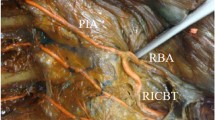Summary
The study presents the incidence of a variant terminal branch of the internal thoracic artery (ITA). The ITA's were cannulated in situ, injected with coloured latex and dissected together with its branches in 62 cadavers. Unlike the usual termination of the ITA bifurcating into the musculophrenic and superior epigastric arteries, this third branch arose from the medial border of the ITA at the level of the 6th costal cartilage. As it descends it inclines medially towards the angle between the xiphoid process and the 7th costal cartilage, giving off 2 or 3 fine branches to the lower sternum. It then passes deep to this angle and can be observed on the anterior surface of the xiphoid process, terminating in fine branches distributed to the inferior aspect of the xiphoid cartilage. It is proposed that this branch at the “trifurcation” of the ITA be termed the xiphoid branch. This branch was noted in 61.3%. An incidence of 30.7% was seen on the right and 21% on the left with bilateral presence in 9.7%. The xiphoid branch contributes to the supply to the lower sternal region and may be of special importance when the collateral supply to the region is compromised in the event of the internal thoracic or superior epigastric artery damage or when used as a conduit in coronary artery by-pass grafts.
Résumé
Cette étude présente la fréquence d'une branche terminale de l'artère thoracique interne (ITA). L'ITA était canulée in situ, injectée avec du latex coloré et disséquée avec ses branches sur 62 cadavres. A la différence de la terminaison classique de l'ITA en deux branches, l'artère musculo-phrénique et l'artère épigastrique supérieure, une troisième branche naissait du bord médial de l'ITA au niveau du 6ème cartilage costal. Cette branche descendait en s'inclinant en dedans vers l'angle formé par le processus xiphoïde et le 7ème cartilage costal en donnant 2 ou 3 fines branches pour la partie inférieure du sternum. Elle passait en profondeur à ce niveau et pouvait être observée sur la face antérieure de l'appendice xiphoïde, se terminant en de fins rameaux distribués à la partie inférieure du cartilage xiphoïde. Il est proposé que cette branche qui correspond à une "trifurcation" de l'ITA, soit dénommée la branche xiphoïdienne. Cette branche est retrouvée dans 61,3 % des cas. Sa fréquence est de 30,7 % sur le côté droit et de 21 % sur le bord gauche et de 9,7 % dans une forme bilatérale. Cette branche xiphoïdienne contribue à vasculariser la partie inférieure du sternum et acquiert une importance spéciale quand la circulation collatérale est compromise en cas d'altération de l'ITA ou de l'artère épigastrique supérieure, ou en cas de l'utilisation de ce conduit pour les pontages artériels coronariens.
Similar content being viewed by others
References
Arnold M (1972) The surgical anatomy of sternal blood supply. J Thorac Cardiovasc Surg 64: 596–610
De Jesus RA, Acland RD (1995) Anatomic study of the collateral blood supply of the sternum. Ann Thorac Surg 59: 163–168
Francel TJ, Dufresne CR, Baumgartner WA, O'Kelly J (1992) Anatomic and clinical considerations of an internal mammary artery harvest. Arch Surg: 1107–1111
Henriquez PJA, Gomes WJ, Prates JC, Buffolo E (1997) Surgical anatomy of the internal thoracic artery. Ann Thorac Surg 64: 1041–1045
Lachman N, Satyapal KS (1996) An unusual branch of the internal thoracic artery. Proceedings of the Anatomical Society of Southern Africa, J. Anat 188: 504
Lachman N, Satyapal KS (1998) Morphometry of the internal thoracic arteries. Surg Radiol Anat 20: 243–247
Rigaud J, Armstrong O, Robert R, Rogez JM, Le Borgne J (1998) Anatomic bases of aortocoronary bypasses: the internal thoracic artery and blood supply of the sternum. Surg Radiol Anat 20: 191–195
Seyfer AE, Shriver CD, Miller TR, Gracber GM (1988) Sternal blood flow after median sternotomy and mobilization of the internal mammary arteries. Surg 104: 899–904
Williams PL, Warwick R, Dyson N, Bannister LH (1989) Gray's Anatomy 37th Edition. Churchill Livingstone, Edinburgh, pp 692–698
Author information
Authors and Affiliations
Rights and permissions
About this article
Cite this article
Lachman, N., Satyapal, K.S. Origin and incidence of xiphoid branch of the internal thoracic artery. Surg Radiol Anat 21, 351–354 (1999). https://doi.org/10.1007/BF01631338
Accepted:
Issue Date:
DOI: https://doi.org/10.1007/BF01631338




